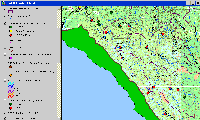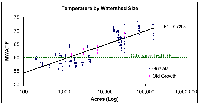| Area |
Wheatfield |
| Topic |
Temperature: MWAT (F) Wheatfield vs. Coho Threshold 1995-2001 |
 Click on image to enlarge (62K). Click here to display a larger version (157K).
Click on image to enlarge (62K). Click here to display a larger version (157K).The map image above shows the Wheatfield drainage with a vegetation and timber size class color scheme developed from a 1994 Landsat image classified by the USFS Spatial Analysis Lab in Sacramento as well as MWATs in Fahrenheit. The mainstem Wheatfield stations all fall within the stressful or lethal range for salmonids. Fuller Creek water temperatures are cool enough to support steelhead but only one Fuller Creek tributary and a small Wheatfield tributary are suitable for coho salmon rearing (62.25 F according to Welsh et al., 2001).
 Click on image to enlarge (127K).
Click on image to enlarge (127K).The map above from the KRIS Gualala Map project shows a Gualala Redwoods, Inc temperature monitoring sites in the lower Wheatfield and lower South Fork with coding for suitability for coho. Sites with floating weekly maximum average water temperatures (MWAT) greater than 16.8 C in all years are coded red while those sites under that threshold are coded green. Sites that are under this threshold in some years but over in others are in yellow.
 Click on image to enlarge (17K).
Click on image to enlarge (17K).The Chart above was taken from Appendix 9 of the Gualala River Watershed Synthesis Report and represents Gualala River locations versus sites labeled "old growth" and is intended to show that water temperatures in smaller streams are naturally cooler than larger streams. The relationship represents data from Henry Alden of Gualala Redwoods, Inc. who also provided information about the old growth sites: "The old growth watersheds, by increasing acreage, are Cow Creek (93% uncut old growth), Squaw Creek (61% uncut old growth) Canoe Creek (62% uncut old growth) and Bull Creek, where the stream flows through 3 miles of uncut old growth, including the Rockefeller Grove, before it gets to the Bull Creek temperature station."
To learn more about this topic click Info Links
 Click on image to enlarge (62K). Click here to display a larger version (157K).
Click on image to enlarge (62K). Click here to display a larger version (157K). Click on image to enlarge (127K).
Click on image to enlarge (127K). Click on image to enlarge (17K).
Click on image to enlarge (17K).